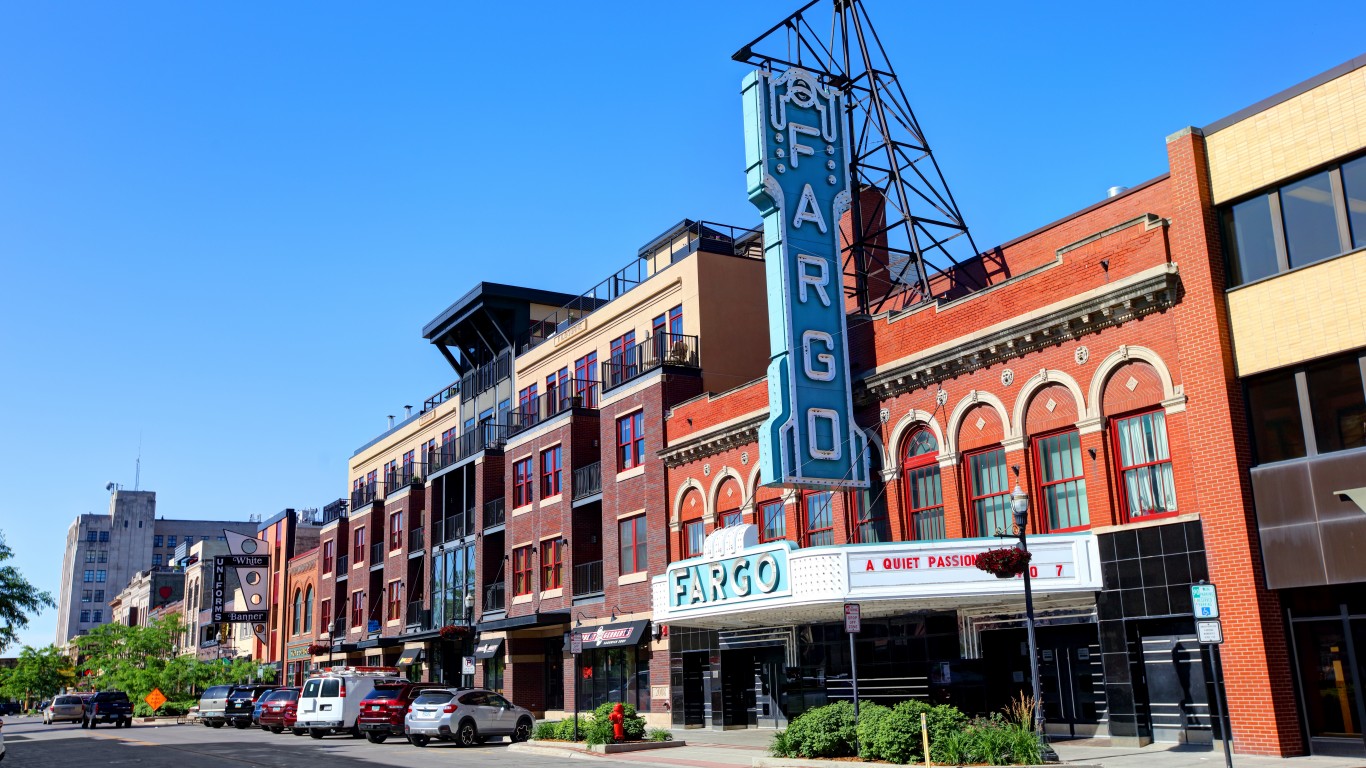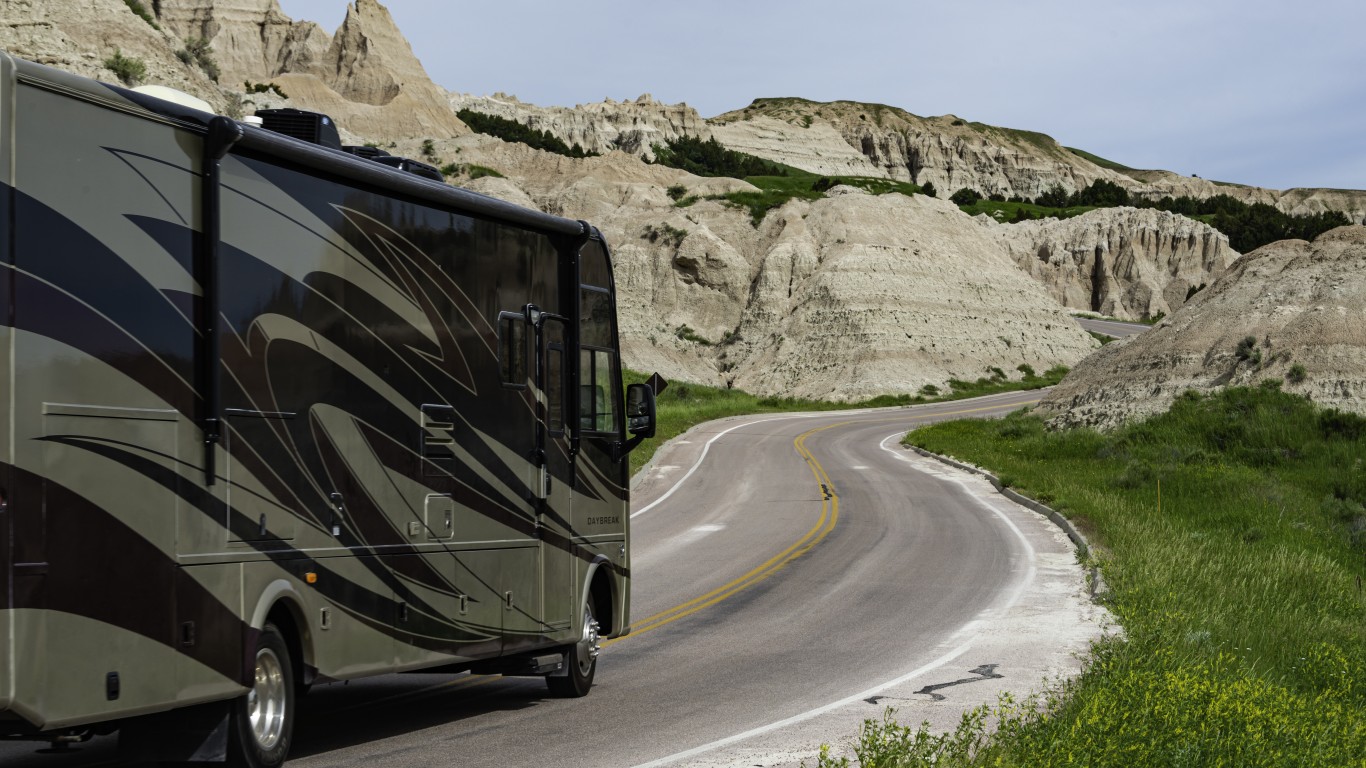
Millions of Baby Boomers have been retiring each year since the first members of this generational group (born between 1946 and 1964) became eligible for Social Security benefits in 2008. The pace has accelerated recently as older Americans have weighed the risks of working during the novel coronavirus pandemic, and decided it was an ideal time to bow out of the labor force. (Let’s hope they considered at least some of these 27 ugly truths about retirement.)
According to an analysis of government data by the Pew Research Center, the number of Boomers who reported they were out of the labor force due to retirement rose by a record 3.2 million last year, more than double the number in 2019.
As of August 2021, the U.S. Social Security Administration reported that there are about 46.9 million retired workers in the United States, making up about 14% of the total population (not counting U.S. territories or the District of Columbia). The distribution of these retired workers is, of course, not evenly divided between the states. The share of retired workers in each state ranges between 9.6% and 18.7%. (Washington D.C. has the lowest share — excluding. territories — with only 8.6% of its population retired.)
To determine the number of retired people in every state, 24/7 Wall St. reviewed data from the U.S. Social Security Administration on the total number of retired workers by state for December 2020. Population figures used in calculating percentages came from U.S. Census Bureau data for 2019.
It turns out that the size of a state’s population doesn’t correlate with its share of retirees. For instance, California and Texas, the top two most populous states, have about 7.6 million retirees between them, but both states rank near the bottom in their percentage of retirees. The country’s third-most populous state, Florida, on the other hand, ranks near the top.
Click here to see the number of retired people in every state
Climate doesn’t appear to be a factor, either. The lure of mild to hot year-round weather is often cited as an attractive draw for older Americans, but the top four states with the largest shares of retirees are located at or near the Canadian border, while Wisconsin and New Hampshire are in the top 10. (These are the best and worst states for a healthy retirement.)

Alabama
> Retired workers: 748,936
> Pct. of population that is retired: 15.3% (18th highest)
[in-text-ad]

Alaska
> Retired workers: 79,077
> Pct. of population that is retired: 10.8% (3rd lowest)

Arizona
> Retired workers: 1,079,667
> Pct. of population that is retired: 14.8% (25th highest)

Arkansas
> Retired workers: 460,240
> Pct. of population that is retired: 15.3% (19th highest)
[in-text-ad-2]

California
> Retired workers: 4,563,824
> Pct. of population that is retired: 11.6% (4th lowest)

Colorado
> Retired workers: 690,452
> Pct. of population that is retired: 12.0% (5th lowest)
[in-text-ad]

Connecticut
> Retired workers: 522,492
> Pct. of population that is retired: 14.7% (24th lowest)

Delaware
> Retired workers: 169,378
> Pct. of population that is retired: 17.4% (3rd highest)

Florida
> Retired workers: 3,625,364
> Pct. of population that is retired: 16.9% (5th highest)
[in-text-ad-2]

Georgia
> Retired workers: 1,330,246
> Pct. of population that is retired: 12.5% (7th lowest)

Hawaii
> Retired workers: 225,111
> Pct. of population that is retired: 15.9% (13th highest)
[in-text-ad]

Idaho
> Retired workers: 272,396
> Pct. of population that is retired: 15.2% (20th highest)

Illinois
> Retired workers: 1,654,623
> Pct. of population that is retired: 13.1% (9th lowest)

Indiana
> Retired workers: 969,120
> Pct. of population that is retired: 14.4% (23rd lowest)
[in-text-ad-2]

Iowa
> Retired workers: 493,211
> Pct. of population that is retired: 15.6% (15th highest)

Kansas
> Retired workers: 413,953
> Pct. of population that is retired: 14.2% (19th lowest)
[in-text-ad]

Kentucky
> Retired workers: 635,809
> Pct. of population that is retired: 14.2% (21st lowest)

Louisiana
> Retired workers: 573,565
> Pct. of population that is retired: 12.3% (6th lowest)

Maine
> Retired workers: 251,087
> Pct. of population that is retired: 18.7% (the highest)
[in-text-ad-2]

Maryland
> Retired workers: 761,526
> Pct. of population that is retired: 12.6% (8th lowest)

Massachusetts
> Retired workers: 921,297
> Pct. of population that is retired: 13.4% (10th lowest)
[in-text-ad]

Michigan
> Retired workers: 1,571,421
> Pct. of population that is retired: 15.7% (14th highest)

Minnesota
> Retired workers: 807,380
> Pct. of population that is retired: 14.3% (22nd lowest)

Mississippi
> Retired workers: 439,690
> Pct. of population that is retired: 14.8% (25th lowest)
[in-text-ad-2]

Missouri
> Retired workers: 919,164
> Pct. of population that is retired: 15.0% (24th highest)

Montana
> Retired workers: 184,587
> Pct. of population that is retired: 17.3% (4th highest)
[in-text-ad]

Nebraska
> Retired workers: 264,178
> Pct. of population that is retired: 13.7% (14th lowest)

Nevada
> Retired workers: 428,286
> Pct. of population that is retired: 13.9% (17th lowest)

New Hampshire
> Retired workers: 228,809
> Pct. of population that is retired: 16.8% (6th highest)
[in-text-ad-2]

New Jersey
> Retired workers: 1,226,008
> Pct. of population that is retired: 13.8% (16th lowest)

New Mexico
> Retired workers: 318,663
> Pct. of population that is retired: 15.2% (21st highest)
[in-text-ad]

New York
> Retired workers: 2,645,425
> Pct. of population that is retired: 13.6% (13th lowest)

North Carolina
> Retired workers: 1,574,403
> Pct. of population that is retired: 15.0% (22nd highest)

North Dakota
> Retired workers: 102,674
> Pct. of population that is retired: 13.5% (12th lowest)
[in-text-ad-2]

Ohio
> Retired workers: 1,661,141
> Pct. of population that is retired: 14.2% (20th lowest)

Oklahoma
> Retired workers: 551,853
> Pct. of population that is retired: 13.9% (18th lowest)
[in-text-ad]

Oregon
> Retired workers: 683,497
> Pct. of population that is retired: 16.2% (10th highest)

Pennsylvania
> Retired workers: 2,056,241
> Pct. of population that is retired: 16.1% (11th highest)

Rhode Island
> Retired workers: 164,439
> Pct. of population that is retired: 15.5% (16th highest)
[in-text-ad-2]

South Carolina
> Retired workers: 857,657
> Pct. of population that is retired: 16.7% (8th highest)

South Dakota
> Retired workers: 141,799
> Pct. of population that is retired: 16.0% (12th highest)
[in-text-ad]

Tennessee
> Retired workers: 1,023,475
> Pct. of population that is retired: 15.0% (23rd highest)

Texas
> Retired workers: 3,062,526
> Pct. of population that is retired: 10.6% (2nd lowest)

Utah
> Retired workers: 308,775
> Pct. of population that is retired: 9.6% (the lowest)
[in-text-ad-2]

Vermont
> Retired workers: 113,550
> Pct. of population that is retired: 18.2% (2nd highest)

Virginia
> Retired workers: 1,147,511
> Pct. of population that is retired: 13.4% (11th lowest)
[in-text-ad]

Washington
> Retired workers: 1,041,832
> Pct. of population that is retired: 13.7% (15th lowest)

West Virginia
> Retired workers: 299,166
> Pct. of population that is retired: 16.7% (7th highest)

Wisconsin
> Retired workers: 950,228
> Pct. of population that is retired: 16.3% (9th highest)
[in-text-ad-2]

Wyoming
> Retired workers: 88,506
> Pct. of population that is retired: 15.3% (17th highest)
Travel Cards Are Getting Too Good To Ignore (sponsored)
Credit card companies are pulling out all the stops, with the issuers are offering insane travel rewards and perks.
We’re talking huge sign-up bonuses, points on every purchase, and benefits like lounge access, travel credits, and free hotel nights. For travelers, these rewards can add up to thousands of dollars in flights, upgrades, and luxury experiences every year.
It’s like getting paid to travel — and it’s available to qualified borrowers who know where to look.
We’ve rounded up some of the best travel credit cards on the market. Click here to see the list. Don’t miss these offers — they won’t be this good forever.
Thank you for reading! Have some feedback for us?
Contact the 24/7 Wall St. editorial team.
 24/7 Wall St.
24/7 Wall St. 24/7 Wall St.
24/7 Wall St. 24/7 Wall St.
24/7 Wall St.


